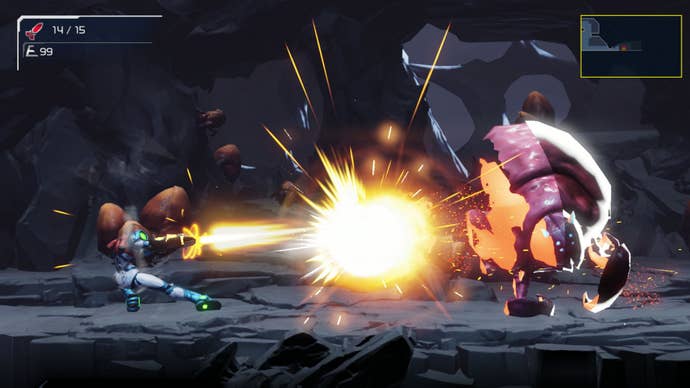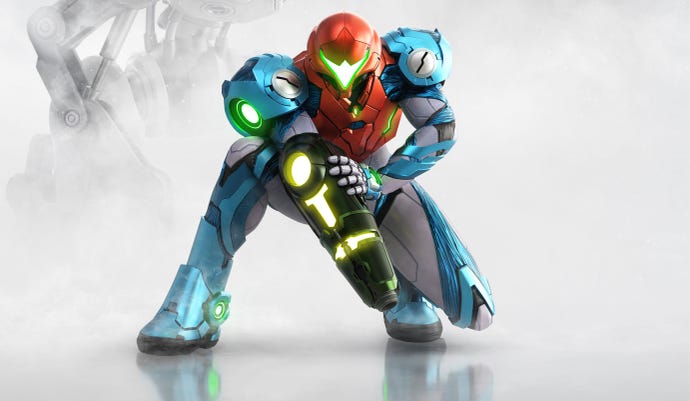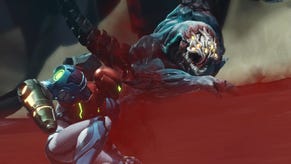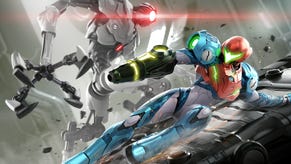Metroid Dread proves that Samus is cooler than Master Chief
For the first time in what feels like forever, a new Metroid game truly gets what made Samus so cool to begin with.
When I was a teenager, I bought a lavish statue of Samus Aran. Crafted by high-end memorabilia company First4Figures, it was a loving recreation of her Varia Suit, as seen in Metroid Prime. At that time of my life, it was a particularly significant purchase - a penniless student, the couple hundred it cost was a major outlay. I chose to pick it up for a simple reason, though: Samus is one of the coolest characters in video game history, and if I could afford one big thing to decorate my shelves, she seemed the perfect fit.
Samus is awesome. Except, of courses, for when she isn’t. Samus has had a rough old time of it. Her reward for starring in one of the best Super Nintendo games, an all-time classic, was a generation-long hiatus. Her return in Metroid Prime was explosive, but it also felt like Prime was sometimes at odds with what her original Japanese creators wanted for her - they continued the story started out on the NES and relegated Prime to a sort of sub-series status. Then it seemed the legacy of the character began to catch up with her - an increased desire to tell a thrilling, engaging story around her exploits began to grow.
That’s probably the crux of the Samus problem. People love her as a character - and that makes developers want to increase her legend through deeper storytelling. Not all of that lands. That means that Sometimes Samus is great - and sometimes not so much. For my money, the more time given to pontificate about the woman who wears the armor in detail, the worse she becomes. It all hits a zenith in the Wii’s Metroid: Other M, a game that gives in to the temptations of anime story machinations that are so rubbish that despite actually playing quite decently, it was critically panned and commercially struggled.
Samus is at her best when she’s silent - or rather, almost silent. It’s not that she as a character doesn’t deserve to have a voice - it’s that she doesn’t need to talk. She is absolutely all business. When you hear from her in the form of a mission update log, it’s clear-cut and simple. There’s no ego there. In the excellent Metroid Dread, she’s joined on her adventure again by ADAM, a friendly artificial intelligence that gives you voice-acted briefings as you venture through the unwelcoming planet ZDR. A less confident story would have crafted a relationship between Samus and the AI, especially considering it’s based on the uploaded personality and memories of her old commanding officer, as depicted in Other M. I can see the version of this game where the AI cracks wise at Samus’ stoic nature repeatedly for ‘laughs’. But there’s none of that here. She listens intently to the briefings… and then she turns, resolute, and forges on. The AI deserves no reply; it’s just a machine, another tool in Samus’ mission.
I think it’s easy to mistake this sort of thing for Samus lacking a character, but I don’t think that’s the case. Just because she’s not quipping about needing a weapon or finishing the fight, or moping about her AI lover as Master Chief does doesn’t mean she’s devoid of personality. In fact, in her best outings, she oozes it.
Remember what I said about how there’s no ego in Samus’ personal logs, which are commonly featured in the openings of Metroid titles? Well, that’s not to say that she’s without ego. In the best of her adventures, it comes over instead in how she acts. It’s here that the animation teams on these games have their work cut out for them: here you have a near-silent character whose personality is primarily showcased through her actions.

Dread is swimming in this stuff. Samus has constant confidence. She faces down enormous enemies with a steadfast stance. She fights with robotic precision, but with a decidedly human swagger. Occasionally the game pulls in for a close-up of her eyes when it really wants to hint at her emotive state - but most of the time, the green glow of her visor is too intense to ever make out her features behind it. It’s always a calculated directorial choice when her eyes are seen. And as she begins to grapple with new powers and abilities, that creep of uncertainness or surprise in her is sold entirely by how she moves. When those powers are fully reckoned with, she uses them in a blunt and purposeful way, as with the rest of her arsenal.
For my money, Metroid Dread has the best animation of any 3D version of Samus. For the purposes of building character, everything she does has utility not just in terms of how this character handles in gameplay, but also in how her personality, attitude, and relationship with the world around her is sold. There’s always the risk in taking a game like this and making it 3D modelled of personality being lost - 3D is rarely as good as hand-drawn art for this sort of thing - but Dread is certainly up there. Dread has reminded me of why I found Samus so compelling that I went and bought an expensive statue of her when I was a skint student.
In a sense, the most impressive thing is that Dread still continues story threads offered up by past games, including some of the more hand-wringing lore about Samus’ past exploits. But it delivers this in a deft way that is closer to Super Metroid than Other M. When it does see fit to drop a major exposition scene, it makes it as dramatic as it can while dispensing with the unnecessary. And Samus - she takes it in, stiffens her spine - and gets on with the job. In Metroid Dread, she's awesome - the most brilliant and bad-ass among her power-armor clad peers. Just as she should be.



.jpg?width=291&height=164&fit=crop&quality=80&format=jpg&auto=webp)





